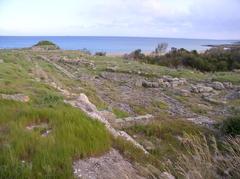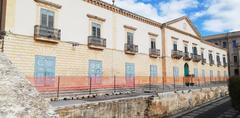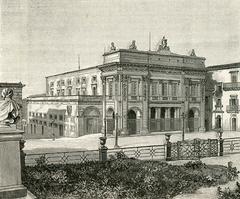Noto Civic Archaeological Museum: Complete Guide to Visiting Hours, Tickets, Collections, and Travel Tips
Date: 14/06/2025
Introduction
Located in the heart of Noto’s UNESCO-listed Baroque center in southeastern Sicily, the Noto Civic Archaeological Museum is a cultural cornerstone that brings to life the ancient and diverse heritage of the Val di Noto region. Its extensive collections and engaging exhibitions highlight the area’s journey from prehistoric settlements, through Greek and Roman eras, to the Byzantine and medieval periods. Reopened in 2024 after decades of closure, the museum now features state-of-the-art accessibility, digital storytelling, and educational programming, making it an essential destination for history enthusiasts and families alike (Classic Sicily, Museo Civico Noto).
Table of Contents
- Introduction
- Historical Evolution of the Museum
- Location, Setting, and Architecture
- Exhibition Layout and Themes
- Permanent and Temporary Collections
- Visitor Information (Hours, Tickets, Accessibility, Getting There)
- Highlights and Visitor Experience
- Special Events and Partnerships
- Accessibility and Inclusivity
- Nearby Attractions and Travel Tips
- Educational and Cultural Impact
- Visual Highlights and Media
- Frequently Asked Questions (FAQ)
- Conclusion and Call to Action
- References
Historical Evolution of the Noto Civic Archaeological Museum
Origins and Early Development
Inaugurated in 1988, the museum was established to preserve and display the archaeological riches of Noto, a city reconstructed after the catastrophic 1693 earthquake that destroyed the original Noto Antica (Italian Traditions). Initially located in Villa Landolina Park, the museum adopted modern methods of interpretation and presentation from its outset.
Closure and Rebirth
A 1990 earthquake led to the museum’s closure, causing its collections to remain inaccessible for more than three decades. With support from the Italian Ministry of Infrastructure and Transport and local partners, the museum reopened in 2024 in the historic Santissimo Salvatore complex, featuring expanded exhibition spaces and renewed commitment to preservation and education (Classic Sicily).
Location, Setting, and Architecture
The museum’s current home is in the lower section of the former Benedictine Monastery of Santissimo Salvatore, situated on Corso Vittorio Emanuele—Noto’s main thoroughfare. Its adaptive reuse within this Baroque architectural landmark seamlessly links Noto’s religious and civic past with its vibrant present. Visitors enjoy striking stained glass windows and views of the city’s bustling historic center (Museo Civico Noto).
Exhibition Layout and Themes
The museum’s ten thematic exhibition rooms chronicle the region’s multilayered history:
- Prehistoric and Castelluccio Culture: Early artifacts from sites such as Mount Alveria and Noto Antica, including tools, ceramics, and funerary objects from the Bronze and Iron Ages.
- Greek and Roman Influence: Objects from the Greek colony of Eloro and the Roman villa at Tellaro, including mosaics, sculptures, and everyday items.
- Byzantine and Medieval Periods: Religious objects and architectural elements reflecting centuries of cultural exchange.
- Jewish Heritage: Rare limestone phylactery and displays referencing local Jewish burial caves (Visit Jewish Italy).
- Contemporary Art: Works by notable Sicilian sculptors, such as Giuseppe Pirrone.
A standout “semi-empty” showcase in the Noto Antica section allows for the ongoing addition of new finds from active excavations, ensuring the museum remains a living institution (Classic Sicily).
Permanent and Temporary Collections
Archaeological Artifacts
- Prehistoric and Protohistoric Finds: Lithic tools, obsidian blades, decorated pottery, and funerary urns dating from the Neolithic to Bronze Age. Major discoveries from Cava d’Ispica and Grotta delle Trabacche.
- Greek and Hellenistic Period: Black-figure and red-figure vases, amphorae, terracotta figurines, Greek inscriptions, and funerary stelae, testifying to the Hellenic influence on the region.
- Roman and Late Antique Artifacts: Mosaic floors, marble fragments, coins, jewelry, oil lamps, and glassware from the 3rd century BCE to the 5th century CE.
- Medieval and Norman Period: Glazed ceramics, bronze crosses, architectural fragments from Byzantine, Arab, and Norman eras.
Epigraphic and Numismatic Collections
Stone inscriptions in Greek, Latin, and medieval scripts, alongside coins from Greek, Roman, and Sicilian rulers, provide insight into the region’s political and economic history.
Local Ethnographic Materials
Displays of handwoven textiles, agricultural tools, religious banners, and historical photographs document the traditional crafts and rural life of the Noto area.
Temporary Exhibitions
Regularly rotating displays highlight recent archaeological discoveries, loaned artifacts from other Sicilian museums, and thematic explorations of local history, art, and technology (Travel Elsewhere).
Visitor Information
Location and Contact
- Address: Museo Civico Archeologico di Noto, Via Roma, 96017 Noto SR, Sicily, Italy
- Phone: +39 0931 812345
- Website: Official Site
Opening Hours
- Tuesday to Sunday: 9:00 AM – 6:30 PM (Last admission: 30 min before closing)
- Monday: Closed
- Public holidays: Check the official website for seasonal updates
Ticket Prices
- Adults: €8
- Reduced (EU citizens 18–25): €4
- Free: Children under 18, residents of Noto, disabled visitors
- Group and school rates: Available on request
Buying Tickets
Tickets can be purchased online via the official website or at the entrance. Booking ahead is recommended during peak periods (Museo Civico Noto).
Guided Tours and Workshops
Expert-led guided tours and educational workshops are available for individuals, families, and school groups. Tactile exhibits and interactive experiences cater to all ages and abilities (Classic Sicily).
Accessibility
- Wheelchair-accessible entrance, ramps, and elevators throughout
- Accessible restrooms and seating areas
- Tactile paths and exhibits for visually impaired visitors
- Bilingual (Italian/English) interpretive materials
- Audio guides in multiple languages (TravelNoto)
Getting There
- On Foot: Centrally located on Corso Vittorio Emanuele, steps from Noto Cathedral
- By Car: Public parking nearby
- By Train: 15-minute drive from Noto train station
- By Bus: Local and regional buses stop in the city center
Highlights and Visitor Experience
- Neolithic Funerary Urns: Geometric motifs and ancient burial practices
- Greek Black-Figure Pottery: Fine vases and amphorae from the 6th century BCE
- Roman Mosaics: Marine-themed panels from Eloro
- Norman Bronze Crosses and Medieval Jewels: Religious and decorative artifacts
- Jewish Limestone Phylactery: Rare evidence of Noto’s medieval Jewish community
- Digital Reconstructions: Virtual tours and 3D models of Noto Antica and local archaeological sites (Museo Civico Noto)
Photography is generally allowed (without flash); always check posted signage.
Special Events and Partnerships
- Cultural Festivals: Extended hours and special programs during the Infiorata di Noto flower festival (May) (Noto by Night)
- Collaborations: Partnerships with the Archaeological Parks of Syracuse and Ragusa, University of Catania, and other institutions ensure dynamic collections and leading research
Accessibility and Inclusivity
The museum is committed to inclusivity:
- Physical accessibility: Ramps, elevators, and rest areas
- Sensory accessibility: Tactile exhibits, audio guides, high-contrast and bilingual signage
- Family-friendly: Interactive displays, child-focused educational materials, group tour facilities
- Cultural sensitivity: Celebrates the area’s Greek, Roman, Byzantine, Jewish, and Christian heritage (Visit Jewish Italy)
Nearby Attractions and Travel Tips
- Noto Cathedral: Iconic Baroque landmark
- Palazzo Ducezio: Historic town hall
- Baroque Churches and Piazzas: Within walking distance
- Ruins of Noto Antica: 8 km from the museum, accessible by car or taxi
- Other Sites: Monte Finocchitto, Grotta Sbriulia, and Eloro archaeological park
Tips:
- Arrive early for a quieter experience
- Allow 1–2 hours for your visit
- Wear comfortable walking shoes
- English is widely spoken at the museum
- Check the website for seasonal hours and special events
Educational and Cultural Impact
The museum plays a vital role in:
- Cultural preservation: Safeguarding artifacts from all eras of Noto’s history
- Community engagement: Educational programs for schools and families, including simulated excavations and hands-on workshops
- Research: Partnerships with universities, support for archaeological projects, and scholarly exchanges
- Tourism: Anchors sustainable, year-round cultural tourism and supports the local economy (Along Dusty Roads)
Visual Highlights and Media
High-quality images, interactive maps, and virtual tours are available on the museum’s official website. Don’t miss photo opportunities of the museum’s Baroque setting and its panoramic windows overlooking historic Noto.
Frequently Asked Questions (FAQ)
Q: What are the museum’s visiting hours?
A: Tuesday–Sunday, 9:00 AM–6:30 PM; closed Mondays. Check the website for updates.
Q: How much are tickets?
A: Adults €8, reduced €4, free for children under 18 and Noto residents.
Q: Is the museum accessible for visitors with disabilities?
A: Yes, with ramps, elevators, accessible restrooms, and sensory-friendly exhibits.
Q: Are guided tours available?
A: Yes, in multiple languages; book in advance for groups.
Q: Can I take photos inside the museum?
A: Non-flash photography is generally permitted; check for restrictions on-site.
Q: What else can I visit nearby?
A: Noto Cathedral, Palazzo Ducezio, other Baroque sites, and the ruins of Noto Antica.
Conclusion and Call to Action
The Noto Civic Archaeological Museum is a vibrant guardian of Sicily’s ancient and medieval heritage, offering visitors an immersive, accessible, and educational journey through time. Its thoughtfully curated collections, innovative digital displays, and commitment to inclusivity make it a must-visit for anyone exploring southeastern Sicily. Combine your museum visit with Noto’s stunning Baroque architecture and surrounding archaeological sites for a rich cultural experience.
Plan your visit today:
- Check the official museum website for the latest hours, ticketing, and events
- Book guided tours for deeper insights
- Download the Audiala app for audio guides and exclusive content
- Follow the museum and Audiala on social media for updates on exhibitions, festivals, and new discoveries
Embark on a journey through the layers of Noto’s past—where history, art, and community meet in one of Sicily’s most captivating destinations.
References
- Noto Civic Archaeological Museum: Visiting Hours, Tickets, and Historical Highlights, 2024, Classic Sicily
- Noto Civic Archaeological Museum: Visiting Hours, Tickets, Collections, and Visitor Guide, 2024, Travel Elsewhere
- Visitor Experience and Accessibility at the Noto Civic Archaeological Museum, 2024, Museo Civico Noto Official Site
- Cultural and Educational Impact, 2024, Along Dusty Roads
- Noto Civic Archaeological Museum: Visiting Hours, Tickets, and Historical Highlights, 2024, Italian Traditions
- Visitor Experience and Accessibility at the Noto Civic Archaeological Museum, 2024, TravelNoto
- Visitor Experience and Accessibility at the Noto Civic Archaeological Museum, 2024, Visit Jewish Italy




